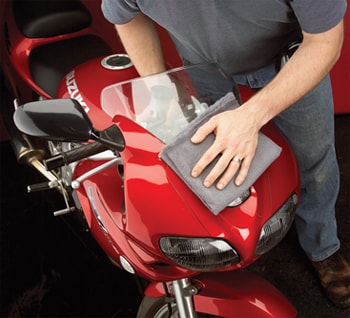A motorcycle is like a piece of jewelry that needs to be treated with a great deal of attention and has to be properly maintained. Cleaning and washing a motorcycle are just as important as the regular technical maintenance activities. Moreover, a clean bike is easier to maintain, as any leaks can be spotted quicker, before getting serious.
Sure, having two beautiful girls in white (and wet) T-shirts and bikini with a sponge and with foam all over, could be a good start. But since it’s not a package that you can buy on your first visit at the local shop, it’s time to stop dreaming, get straight to business and learn how to properly wash your bike... yourselves. Trust us when we say... the pleasure is much more intense during the process and after you’re done as well.
Getting Ready
Whether it’s a cruiser or a sports bike, every rider knows that washing a motorcycle is a very different task than washing a car. Motorcycles feature a variety of surface materials that should be treated differently, such as paint, plastic, chrome, leather, and rubber, altogether on a much smaller area. There also plenty of other hard to reach small areas that need to be cleaned and dried thoroughly, so it’s very important to know the basics when performing a wash.
Most importantly, you must let the engine cool down before washing the bike, as it can cause a lot of damage or actually crack your engine, and this is something that you wouldn’t like to happen... Meanwhile, prepare yourself. This means to take off your watch, rings and other jewelry. Not because they could be damaged, but they could scratch your bike. Belts and jackets with metal parts attached should also be removed. If you are a woman, you can remove everything else as well...
Apply the cleaning solution and use the sponge to clean the paint and plastic areas of the bike. Now rinse it off with a gentle stream of water from a hose, or by pouring water from the bucket. A cleaning brush is best for dirtier metal areas, and a long bristled brush for trickier spots, which are harder to reach. Using a degreaser, scrub the motorcycle’s hard parts, like the swingarm or the exhaust pipes, carefully and individually with a rough rag. Clean the tires with rubber cleaner and a sponge.
When you’re finished, dry the bike using micro fiber cloths, as they are less likely than cotton to leave any residue behind. Chains should be degreased and lubricated after drying. When it’s all done, take your bike for a short ride around the block, as it will eliminate any water that got into the exhaust.
Most importantly, you must let the engine cool down before washing the bike, as it can cause a lot of damage or actually crack your engine, and this is something that you wouldn’t like to happen... Meanwhile, prepare yourself. This means to take off your watch, rings and other jewelry. Not because they could be damaged, but they could scratch your bike. Belts and jackets with metal parts attached should also be removed. If you are a woman, you can remove everything else as well...
The Washing Kit
After you’re done strippin’ yourself, it’s time to get all that you need for the washing process you’re about to start. This should include:- soft, clean cloths, some for washing and some for drying and polishing
- special wheel cleaner
- leather conditioner for the saddle and any other leather accessories
- clean sponges
- motorcycle cleaning solution (soap or liquid detergent could be an alternative)
- a bucket for mixing solutions
- a brush for wheel cleaning
- oil and grease cleaner
- gloves, if you want to keep your hands clean
The Process
Now that you have all that you need, let’s begin the ‘dirty’ job. Though a garden hose with a gentle spray is the best water source, some may just settle with some buckets. Pour in some cleaning solution and use warm water with the mix, as it will increase its solvency. You should also consider pre-soaking the bike first. While soaking it from top to bottom, avoid areas like the transmission box, exhaust, and air filter. Use some bug and tar removers, but don’t scrub too hard and be sure you don’t use the same sponge again in the process.Apply the cleaning solution and use the sponge to clean the paint and plastic areas of the bike. Now rinse it off with a gentle stream of water from a hose, or by pouring water from the bucket. A cleaning brush is best for dirtier metal areas, and a long bristled brush for trickier spots, which are harder to reach. Using a degreaser, scrub the motorcycle’s hard parts, like the swingarm or the exhaust pipes, carefully and individually with a rough rag. Clean the tires with rubber cleaner and a sponge.
When you’re finished, dry the bike using micro fiber cloths, as they are less likely than cotton to leave any residue behind. Chains should be degreased and lubricated after drying. When it’s all done, take your bike for a short ride around the block, as it will eliminate any water that got into the exhaust.
